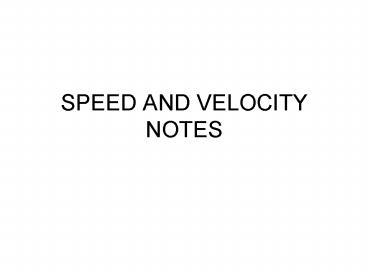SPEED AND VELOCITY NOTES - PowerPoint PPT Presentation
1 / 13
Title:
SPEED AND VELOCITY NOTES
Description:
SPEED AND VELOCITY NOTES SPEED AND VELOCITY NOTES Distance is a measure of how far an object has moved and is independent of direction. If a person travels 40m due ... – PowerPoint PPT presentation
Number of Views:132
Avg rating:3.0/5.0
Title: SPEED AND VELOCITY NOTES
1
SPEED AND VELOCITY NOTES
2
Distance is a measure of how far an object has
moved and is independent of direction. If a
person travels 40m due east, turns and travels
30m due west, the distance traveled is 70m.
3
Displacement has both magnitude (measure of the
distance) and direction. Displacement is a
change of position in a particular direction. For
example 40m east is a displacement.
4
- Total or final displacement refers to both the
distance and direction of an objects change in
position from the starting point or origin.
Displacement only depends on the starting and
stopping point. - Displacement does not depend on the path taken.
- If a person travels 40m due east, turns and
travels 30m due west, the total displacement of
the person is 10m east. - If a person travels 40m east and then travels
another 50m east the total displacement is 90m
east.
5
Speed is how fast something is going. It is a
measure of the distance covered per unit of time
and is always measured in units of distance
divided by units of time. (The term per means
divided by)
6
Speed is a rate as it is a change (change in
distance) over a certain period of time. Speed
is independent of direction.
7
- The speed of an object can be described two ways
- Instantaneous speed is the speed at a specific
instant. Initial speed and final speed are
examples of instantaneous speed. - A speedometer measures instantaneous speed.
8
(No Transcript)
9
Velocity is a vector quantity, it has a direction!
10
In the equation, v can represent either
velocity or speed and d can represent either
displacement or distance, depending on the
context of the problem.
11
The term speed or velocity refers to average
speed or velocity. You must determine the
given information in a problem using the
correct units. Using the formula, v d/t, you
must be able to calculate average speed.
12
When calculating average speed using v d/t
the average speed for the trip equals the total
distance divided by the total time. Ignore the
direction of the motion. You must be able to
calculate average velocity.
13
- When calculating average velocity using v
d/t the average velocity equals the total
displacement divided by the total time. - The total displacement may be different from the
total distance. - When indicating the average velocity, direction
must be given and the average - velocity will have the same direction as the
total displacement.































